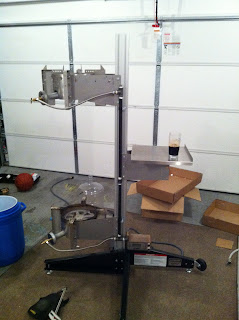Last summer I was having a heck of a time keeping my beers fermenting in an acceptable fermentation range. The general range is usually around 64 - 72 degrees Fahrenheit. Unfortunately since it was summer, the temps were more like 74 - 78 degrees. I kinda solved the problem by putting the fermenters in a bucket filled with water and ice bottles. This would bring the temp down to an acceptable range, but was quite a hassle and was usually hit or miss.
Once the season turned to fall and the garage was back to acceptable fermentation temperatures, I decided I needed to get a chest freezer to ferment in. I had seen a number of threads on
homebrewtalk.com where people had showed off the fermentation chamber. Sometimes people used a freezer or fridge, and sometimes people built these contraptions with insulation attached to a mini fridge.
I went on craigslist and found myself a nice old 16 cubic foot chest freezer. I only paid 40 bucks for it. Now it is probably from the 70's or 80's, but it gets the job done. The people were probably happy I paid them to haul it away for them. Anyways, I got myself a johnson temperature controller from
Northern Brewer, hooked it up to the freezer, and I currently have it set at a range from 35-39 degrees. In the summer I'll bump it up to 65-69 or something like that.
Right now I'm using the chamber to crash cool my beers after secondary fermentation and to house and carb up my kegs before I take them inside to the kegerator. It can easily hold my 5lb co2 tank, and about 6 corny kegs, or a few better bottles and a couple kegs, depending on how the beer pipeline is doing.
I originally got my kegging gear from
kegconnection.com. That is a great store with great products, service, etc. However, a few months back my co2 bottle with regulator fell over and banged up the regulator so the gauge which tells me how much co2 I have left, was not working properly because the faceplate was bent.
So I decided to upgrade. I got a new regulator and hose from Northern Brewer. I really like their set up. They use clear 1/4" tubing for the gas lines. This is way more flexible than the red co2 tubing I had before. They other good thing is that you have the option to get a regulator and distributor with 1/4" MFL shutoffs instead of just having barbed ends. This is way better. So I have a 3 way distributor. Basically so I can carb up 3 kegs at once and it is easy to take off the quick disconnects when I want to use my Blichmann Beer Gun.
Here are a few pics of the system:



Here is a pic of my old regulator and red tubing (which I didn't like so much):

Update - 2011/03/24
I just figured out that kegconnection sells replacement gauges for taprite regulators for like $9. So technically I could have saved myself nearly 60 bucks and just fixed the regulator I already have. However, I do like the MFL things on the new one and I'm glad I replaced the co2 lines, so I don't really mind shelling out the extra dough.



















